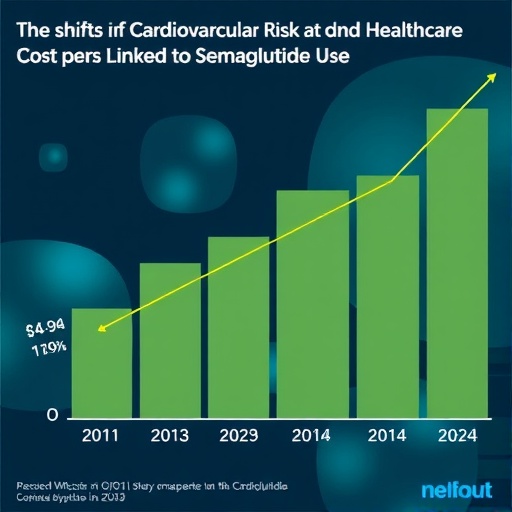In a landmark cohort study recently published in JAMA Network Open, researchers have unveiled compelling evidence linking the initiation of semaglutide—a glucagon-like peptide-1 (GLP-1) receptor agonist—with notable reductions in body weight and key cardiovascular risk factors. This finding holds significant promise for the management of obesity and related metabolic dysfunctions, yet it also raises critical questions regarding the broader economic ramifications of therapy outside the direct cost of the drug itself.
Semaglutide has surged to the forefront of pharmacological interventions targeting obesity, leveraging its unique mechanism to enhance insulin secretion while simultaneously suppressing appetite via central nervous system pathways. Prior clinical trials had underscored its efficacy in controlled environments, but real-world evidence remained limited. This study fills that gap by exploring the medication’s impact within routine clinical practice, where patient adherence and comorbidity management challenge efficacy outcomes.
The cohort under investigation comprised adults prescribed semaglutide, monitored over a period to evaluate changes not only in weight metrics but also in cardiovascular risk profiles, which include parameters such as blood pressure, lipid panel components, and glycemic control. The observed reductions in weight are clinically significant, given that even modest weight loss can translate into improved metabolic health and a decrease in the incidence of complications such as type 2 diabetes and atherosclerotic cardiovascular disease.
Crucially, the study goes beyond purely physiological metrics, shedding light on the nuanced relationship between therapeutic benefit and health care resource utilization. While semaglutide use corresponded with improved clinical biomarkers, there was a concurrent increase in health care expenditures—excluding the acquisition cost of the drug—suggesting that intensified monitoring, management of side effects, or additional healthcare encounters may partially offset the financial gains from improved health outcomes.
Such findings highlight an ongoing tension in modern medicine: the balance between innovative, effective treatments and their economic sustainability within healthcare systems. The long-term cost-effectiveness of semaglutide hinges not only on the drug’s direct effects but also on its broader influence on healthcare delivery, patient adherence, and downstream medical needs.
Mechanistically, semaglutide mimics the incretin hormone GLP-1, enhancing insulin release in a glucose-dependent manner and delaying gastric emptying. These pathways collectively improve glycemic control and promote satiety, which underpins its dual action in managing type 2 diabetes and obesity. Importantly, the drug’s cardiovascular benefits may arise from these metabolic effects as well as potential direct actions on the vasculature and myocardium.
While the reductions in cardiovascular risk factors observed in this cohort are encouraging, translating such changes into tangible reductions in cardiovascular events requires longitudinal studies with longer follow-up periods. The current research emphasizes the necessity of continuous patient monitoring to detect any emergent adverse effects or modest rebounds in weight and risk factors.
Epidemiologically, obesity remains a global public health crisis, with downstream effects permeating multiple organ systems and driving morbidity and mortality. Pharmacological interventions like semaglutide offer a complementary approach to lifestyle modification, which remains the cornerstone of therapy but often falls short in addressing severe or refractory obesity.
The reported increase in healthcare expenditures, excluding the cost of semaglutide itself, introduces a layer of complexity for policymakers and payers. This uptick could reflect increased frequency of physician visits, laboratory testing, or specialist referrals, particularly in the context of managing comorbid conditions or side effects, necessitating a more nuanced understanding of care pathways in patients on GLP-1 receptor agonists.
Future research directions should prioritize comprehensive cost-benefit analyses incorporating both direct and indirect healthcare costs, quality-adjusted life years (QALYs), and patient-reported outcomes. Such data will clarify the sustainability and real-world effectiveness of semaglutide in diverse populations and healthcare settings.
Moreover, understanding patient selection criteria to optimize therapeutic benefit while minimizing unnecessary healthcare utilization will be vital. Personalized medicine approaches, possibly integrating biomarkers predictive of response, could refine semaglutide’s role in obesity management frameworks.
In summary, this rigorous observational study adds critical real-world evidence supporting semaglutide’s efficacy in weight reduction and cardiovascular risk improvement among adults. However, it simultaneously underscores a pressing need to delineate the long-term economic implications of its use outside clinical trials. As obesity rates continue to climb, balancing clinical efficacy with health economics will be fundamental in shaping future guidelines and access to this promising therapeutic class.
Corresponding authors Jason Abaluck, PhD, and Yuan Lu, ScD, affiliated with Yale University, emphasize that while semaglutide presents a robust clinical tool, strategic evaluation of its broader impact on healthcare systems is essential for informed decision-making. Stakeholders including clinicians, patients, payers, and policymakers must collaboratively navigate these complex dynamics to optimize patient outcomes.
The study’s insights pave the way for ongoing dialogue around how innovative pharmaceuticals can best be integrated into routine medical practice, ensuring that advances in science translate into durable, equitable health improvements without disproportionate economic burdens.
Subject of Research: Semaglutide initiation and its effects on weight, cardiovascular risk factors, and healthcare expenditures in adults.
Article Title: [Not provided]
News Publication Date: [Not provided]
Web References: (doi:10.1001/jamanetworkopen.2025.26013)
Keywords: Cardiovascular disorders, Risk factors, Health care, Medications, Pharmaceuticals, Drug delivery, Cohort studies, Adults, Weight loss, Economics, Patient monitoring




